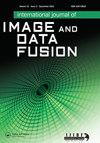创建融合sUAS和TLS点云的虚拟现实环境
IF 1.8
Q3 REMOTE SENSING
International Journal of Image and Data Fusion
Pub Date : 2020-01-29
DOI:10.1080/19479832.2020.1716861
引用次数: 15
摘要
摘要近年来,沉浸式虚拟现实已被应用于工程、科学和教育等学科。激光扫描和无人驾驶航空系统等点云技术在创建虚拟环境方面变得非常重要。本文讨论了利用3D点云数据创建适合沉浸式和交互式虚拟现实的虚拟环境。同时使用激光扫描和sUAS点云。这些点云使用定制算法进行合并,该算法识别主数据集(激光扫描仪)中的数据缺口,并用从属数据集(sUAS)的数据填充,从而形成更完整的数据集,用于地形建模和对象的3D建模。然后,使用定制的自由纹理对地形和3D对象进行纹理处理,以在对象中提供真实感。创建的虚拟环境是宾夕法尼亚州立大学威尔克斯-巴雷校区的一部分的数字副本。该虚拟环境将用于沉浸式和交互式测量实验室,以评估沉浸式虚拟现实在测量工程教育中的作用。本文章由计算机程序翻译,如有差异,请以英文原文为准。
Creating a virtual reality environment with a fusion of sUAS and TLS point-clouds
ABSTRACT In recent years, immersive virtual reality has been used in disciplines such as engineering, sciences, and education. Point-cloud technologies such as laser scanning and unmanned aerial systems have become important for creating virtual environments. This paper discusses creating virtual environments from 3D point-cloud data suitable for immersive and interactive virtual reality. Both laser scanning and sUAS point-clouds are utilised. These point-clouds are merged using a custom-made algorithm that identifies data gaps in the master dataset (laser scanner) and fills them with data from a slave dataset (sUAS) resulting in a more complete dataset that is used for terrain modelling and 3D modelling of objects. The terrain and 3D objects are then textured with custom-made and free textures to provide a sense of realism in the objects. The created virtual environment is a digital copy of a part of the Penn State Wilkes-Barre campus. This virtual environment will be used in immersive and interactive surveying laboratories to assess the role of immersive virtual reality in surveying engineering education.
求助全文
通过发布文献求助,成功后即可免费获取论文全文。
去求助
来源期刊

International Journal of Image and Data Fusion
REMOTE SENSING-
CiteScore
5.00
自引率
0.00%
发文量
10
期刊介绍:
International Journal of Image and Data Fusion provides a single source of information for all aspects of image and data fusion methodologies, developments, techniques and applications. Image and data fusion techniques are important for combining the many sources of satellite, airborne and ground based imaging systems, and integrating these with other related data sets for enhanced information extraction and decision making. Image and data fusion aims at the integration of multi-sensor, multi-temporal, multi-resolution and multi-platform image data, together with geospatial data, GIS, in-situ, and other statistical data sets for improved information extraction, as well as to increase the reliability of the information. This leads to more accurate information that provides for robust operational performance, i.e. increased confidence, reduced ambiguity and improved classification enabling evidence based management. The journal welcomes original research papers, review papers, shorter letters, technical articles, book reviews and conference reports in all areas of image and data fusion including, but not limited to, the following aspects and topics: • Automatic registration/geometric aspects of fusing images with different spatial, spectral, temporal resolutions; phase information; or acquired in different modes • Pixel, feature and decision level fusion algorithms and methodologies • Data Assimilation: fusing data with models • Multi-source classification and information extraction • Integration of satellite, airborne and terrestrial sensor systems • Fusing temporal data sets for change detection studies (e.g. for Land Cover/Land Use Change studies) • Image and data mining from multi-platform, multi-source, multi-scale, multi-temporal data sets (e.g. geometric information, topological information, statistical information, etc.).
 求助内容:
求助内容: 应助结果提醒方式:
应助结果提醒方式:


